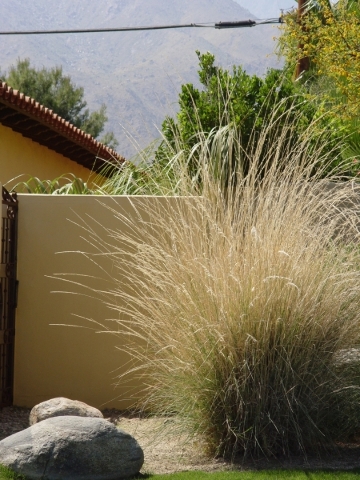Autumn in Las Vegas is for grasses
As summer flowers fade, dry winds arrive to define the fall season, when tall animated ornamental grasses dominate the late garden. Because grasses bloom in mid- to late summer, this is the time when they carry the landscape to well beyond cold weather hits. Few novice gardeners really understand the way grasses flower, but this knowledge is vital to selecting the most sustainable ornamental grasses for your garden.
Grasses are wind-pollinated plants. They don't have flowers colored to attract bees and other pollinators. Grass flowers are designed to greet the wind, their pollen vector. Flowers are produced on stiff, wandlike stems that rise well above the plant's foliage to stand freely in the wind. This position allows the female flower parts to catch pollen grains without interference from shorter plants.
When grass flowers are pollinated, they start producing seed, which gives the tall stems a whole new look. As seed matures, green grass foliage fades to gold, rust or other autumn earth tones as they gradually die back for the winter.
The same winds that carry the pollen also help the seeds to scatter, some aided by light fluffy fibers to be more easily caught and carried away to spread the species. With seed heads remaining well into winter, the more attractive are left in place to provide visual interest in the cold, dormant garden.
Because the grasses are so visually similar, it can be hard to know which ones are best for your landscape. Those that originate close to your immediate region will be the safest choice and these often naturalize.
Cold hardy grasses with an enormous home range mean widespread adaptability. This is so with such as lush, big bluestem (Andropogon gerardii) affectionately dubbed "monarch of the prairie grasses" because of its size, rising to 8 feet under optimal conditions. Its home range extends from Mexico to Canada.
From California and the Southwest comes the ideal native grass for hot, dry and drought conditions. Deer grass (Muhlenbergia rigens) is the best grass for arid zones and where water supply is limited. This is not a showy flowered grass, but its texture is truly remarkable on such a large rounded form. A second species, pink muhly (Muhlenbergia capillaris) produces amazing flower spikes in a rich magenta pink for unique color in the late season.
These grasses stand tough in the succulent and gravel scenario and take heat in the low desert, even in broiling boulevard medians. This is a better, more long-lived choice than popular fountain grasses (Pennisetum), which are notoriously invasive in Western wild lands where there is sufficient moisture.
The greatest genus of all in both size and diversity is Miscanthus, which contains many species from Asia, including Miscanthus sinensis, the most well-known in American gardens. This is considered the most beautiful of all ornamental grasses, and breeders have developed many new and exciting cultivars with striped leaves and varying colors. Not as cold-hardy as big bluestem and not nearly as drought-resistant as deer grass, this group presents the ideal for temperate-zone gardens.
All three of these large outstanding ornamental grasses make an outstanding single specimen. They can also be arranged in small groups just as they would in nature. They are amazing in association with boulders, dry streambeds and in rigid layouts of Spartan modern landscapes. They are chameleons because their surroundings define how they look and feel in space and with plants and other elements.
Sun-drenched ornamental grasses are a must-have for any garden because nothing comes close to its look. Whether you select North American natives, regional natives or imported Asian species, your fall garden will never be dull again.
— Maureen Gilmer is an author, horticulturist and landscape designer. Learn more at www.MoPlants.com.



















